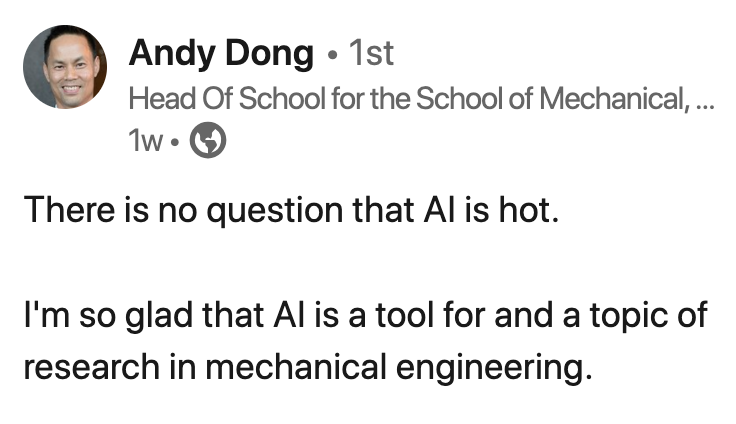I’m so glad that AI is a tool for and a topic of research in mechanical engineering.
This wasn’t always the case. “Way back in the 90’s”, many people asked if the research that I was performing for my PhD in mechanical engineering was actually mechanical engineering — because the topic was statistical learning of a model of a “language of design”, i.e., AI. I wanted to develop an approach to learn a model of a design from natural language. The method I cobbled together used an NLP parser (adapted from freeWAIS) and a custom-built Bayesian network learning algorithm (which I think took >24 hours to run on a Sun SPARCstation Voyager for what today would be considered a small dataset) to learn a model of a design as a belief network. I wrote the code in LISP and C.
This research went on to win a best paper at the Artificial Intelligence in Design Conference in 1996 and then was republished in the journal Artificial Intelligence in Engineering. I attach the paper because it’s not easy to get anymore and to remind myself and my graduate students that it’s totally fine not to know exactly what you’re doing when you’re doing your PhD research. And, may I never ever again see the error message, “SIGSEGV: Segmentation Fault”.
Also, note the email addresses. “Jerry” was, I think, a Sun SPARCstation LX and “euler” was the department’s DEC Alpha. The lab also had a machine named “aAice” after my supervisor and co-author on this paper Alice Agogino. (Note from Alice Agogino, our lab had two computer naming themes at the time: Names of the Grateful Dead and Characters from Alice in Wonderland.)
Dong, A., & Agogino, A. M. (1997). Text analysis for constructing design representations. Artificial Intelligence in Engineering, 11(2), 65–75. doi:10.1016/S0954-1810(96)00036-2
Andy Dong’s original post was on Linkedin.

Abstract
An emerging model in concurrent product design and manufacturing is the federation of workgroups across traditional functional ‘silos’. Along with the benefits of this concurrency comes the complexity of sharing and accessing design information. The primary challenge in sharing design information across functional workgroups lies in reducing the complex expressions of associations between design elements. Collaborative design systems have addressed this problem from the perspective of formalizing a shared ontology or product model. We share the perspective that the design model and ontology are an expression of the ‘meaning’ of the design and provide a means by which information sharing in design may be achieved. However, in many design cases, formalizing an ontology before the design begins, establishing the knowledge sharing agreements or mapping out the design hierarchy is potentially more expensive than the design itself. This paper introduces a technique for inducing a representation of the design based upon the syntactic patterns contained in the corpus of design documents. The association between the design and the representation for the design is captured by basing the representation on terminological patterns at the design text. In the first stage, we create a ‘dictionary’ of noun-phrases found in the text corpus based upon a measurement of the content carrying power of the phrase. In the second stage, we cluster the words to discover inter-term dependencies and build a Bayesian belief network which describes a conceptual hierarchy specific to the domain of the design. We integrate the design document learning system with an agent-based collaborative design system for fetching design information based on our ‘smart drawings’ paradigm.
Andy Dong received his PhD in 1997 from UC Berkeley with dissertation: “The Management of Design Information: A Decision-Analytic Approach”
____________________________________________
The Management of Design Information: A Decision-Analytic Approach
Andy Dong
Abstract
Doctoral Dissertation
University of California at Berkeley
1996/97
This dissertation describes the development of an autonomous decision-making system that is situated in dynamic design environments over extended periods of time and entrusted with the task of managing and retrieving design information. The system orchestrates information resource management in collaborative design by employing a design information infrastructure consisting of “smart drawings” and a decision-analytic machinery enriched with a learned model of the design. The system learns an extensional model of the mechanical by processing, over the lifetime of the design cycle, streams of information communicated by the designers in the form of full-text documentation. The analytical machinery of decision-making uses the measure of expected value of perfect information (EVPI) to make design-time decisions about the ideal questions to pose of the system to optimize the retrieval of useful information.
The fundamental proposition of this research program focuses on constructing a formal methodology to learn an approximate textual model of the design and to perform inference over that model to ascertain the functional specification and decomposition of the design. The model permits the agent to engage in an effective dialogue with the designers. To build the model, the general goal is to extract relationships between the features and functions of the design from documents generated by the engineers. Inferring relationships between the features binds together disparate pieces of information comprising the design, into complex design documents called “smart drawings.” The system includes: a natural language processing component which parses design documents into keywords or phrases; a clustering algorithm which organizes the keywords or phrases into groups which describe principal features of the design; techniques for applying belief networks to the task of learning the decomposition of the design and inferring the mutual impact of components or functions of the design; and an expected value of perfect information engine to augment retrieval requests by identifying the most valuable search variables.
By learning the content of design documents and assisting engineers in understanding the design through semi-autonomous interpretation of information, the mechanical design language interpreter fits into a part of a larger computer-supported collaborative work enterprise supporting incremental addition of content, interaction with the user and with other tools, and reuse of content according to the preferences of the engineer.
Other AI-oriented dissertations from the 1990’s:
| 1989/90 | Fariborz Nadi | “Modeling of Complex Manufacturing Processes via Integration of Influence Diagrams and Neural Networks” |
| 1989/90 | Robert K. Paasch | “Management of Uncertainty in Sensor Based Diagnostic Expert Systems” |
| 1989/90 | Jonathan Cagan | “Innovative Design of Mechanical Structures from First Principles” |
| 1990/91 | Ming-Lei Tseng | “Integrating Neural Networks with Influence Diagrams for Multiple Sensor Diagnostic Systems” |
| 1995/96 | Andy Dong | “Kai Goebel“”Management of Uncertainty in Monitoring and Diagnosis of Mechanical Systems Using Fuzzy Techniques” |
| 1997/98 | Anil Varma | “Intelligent Distributed Design Systems: A Machine-Learning Approach” |
